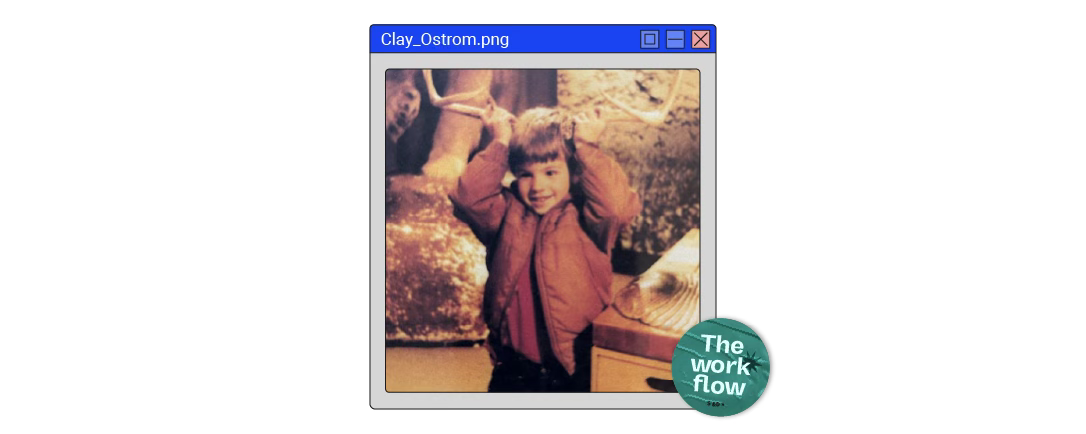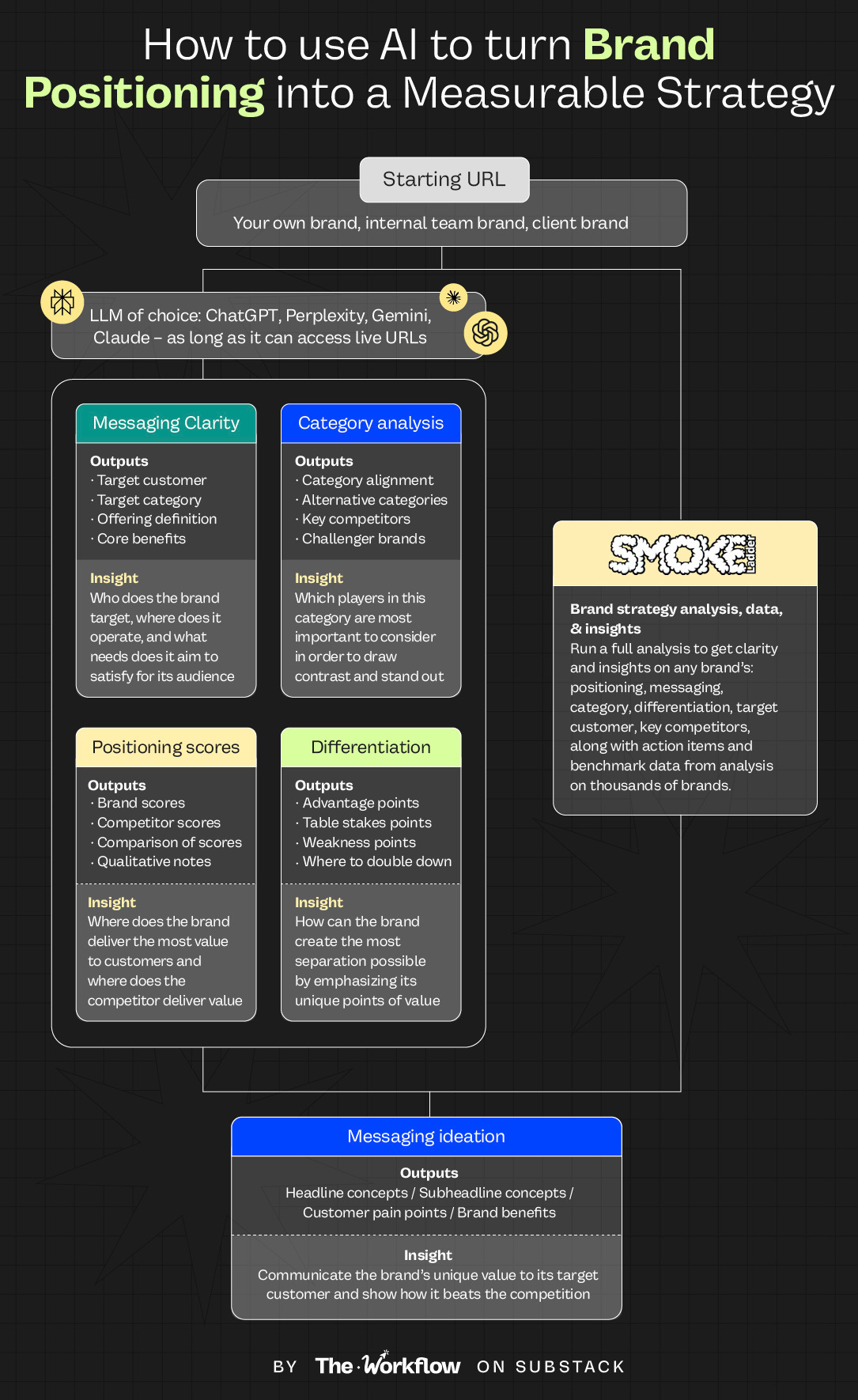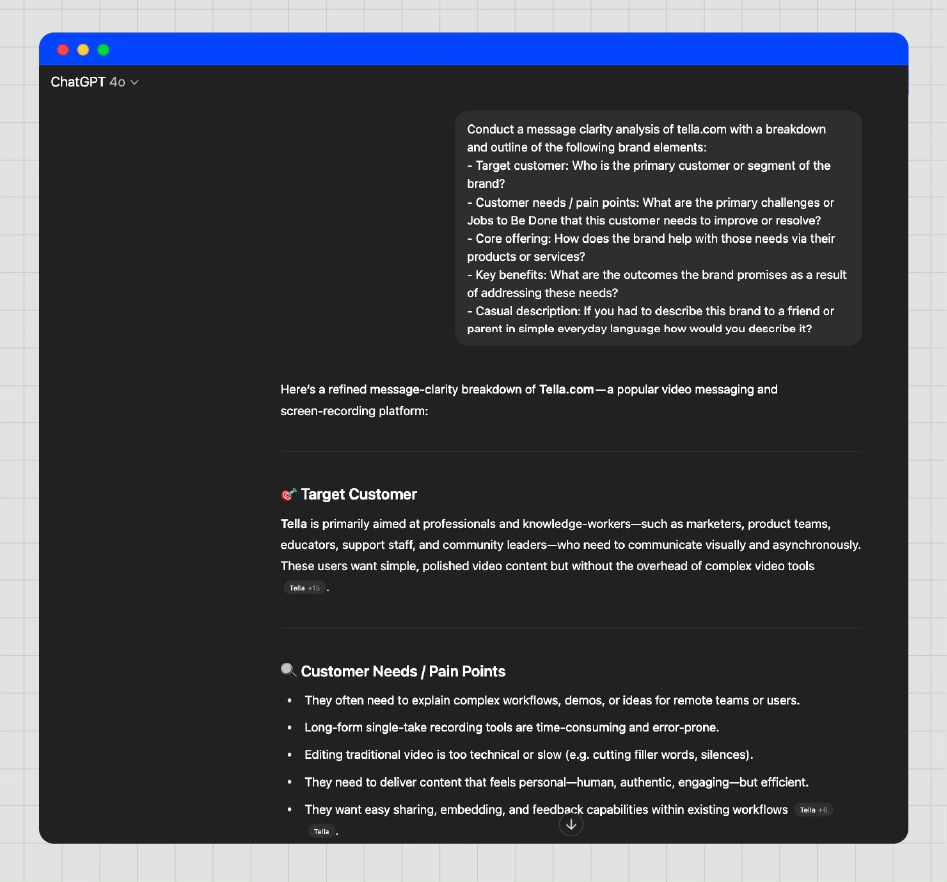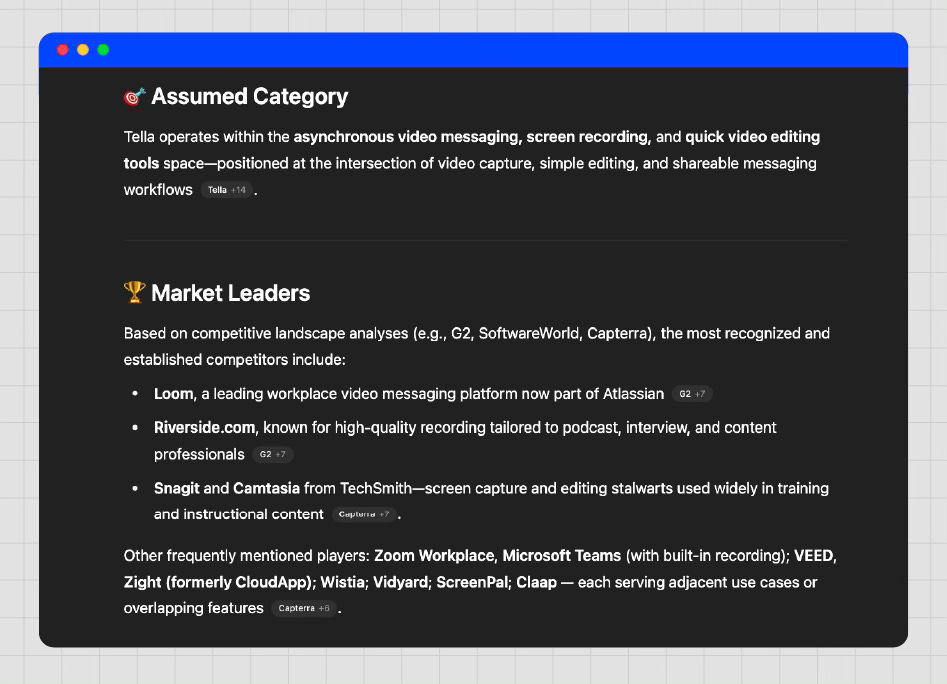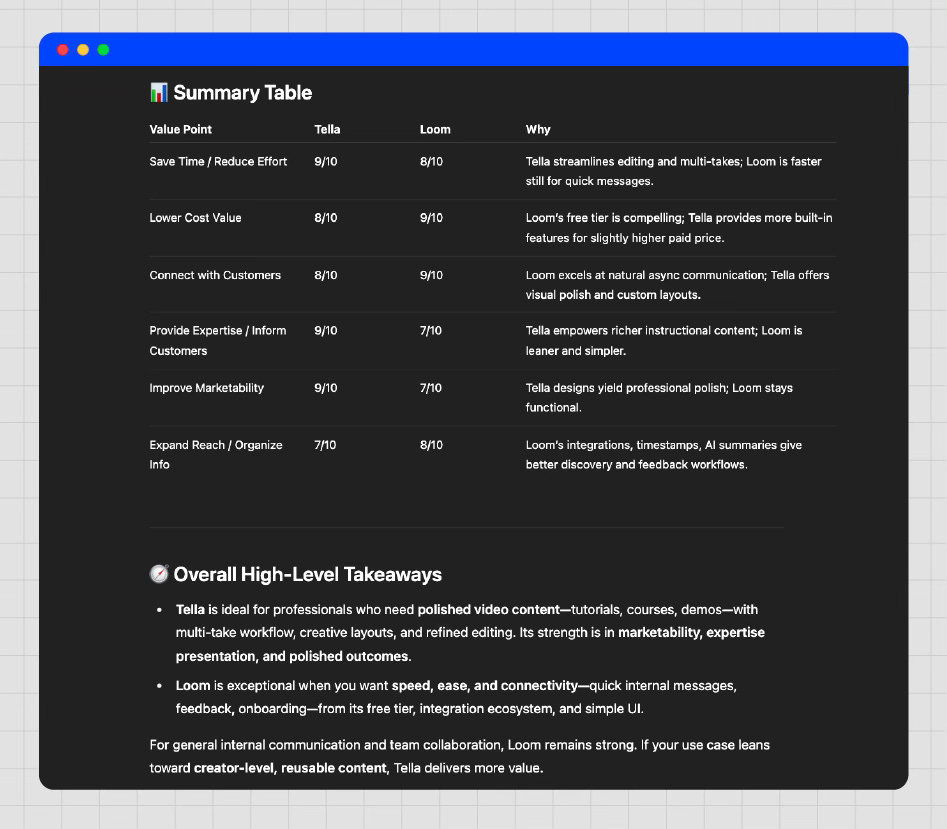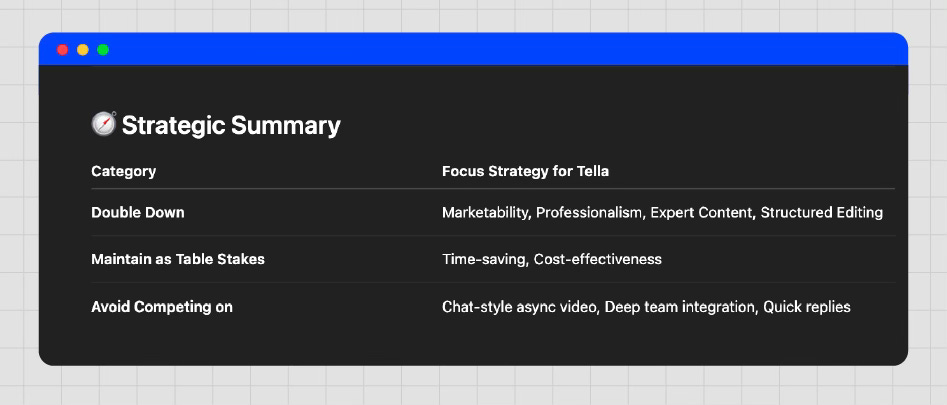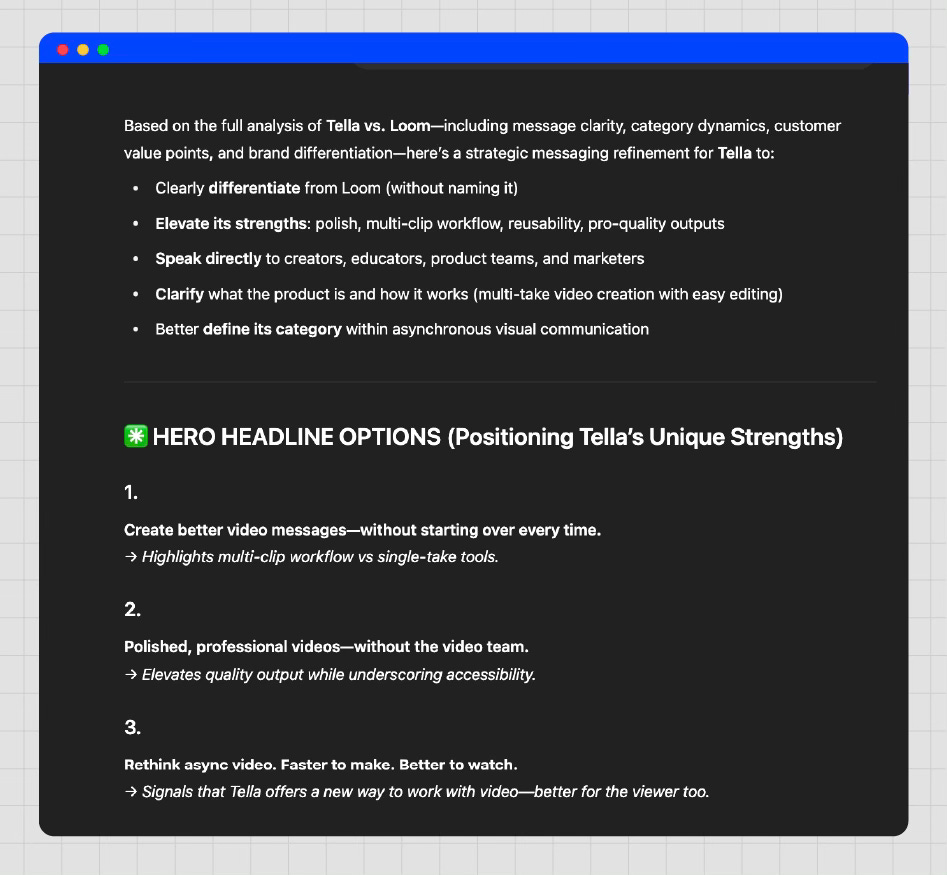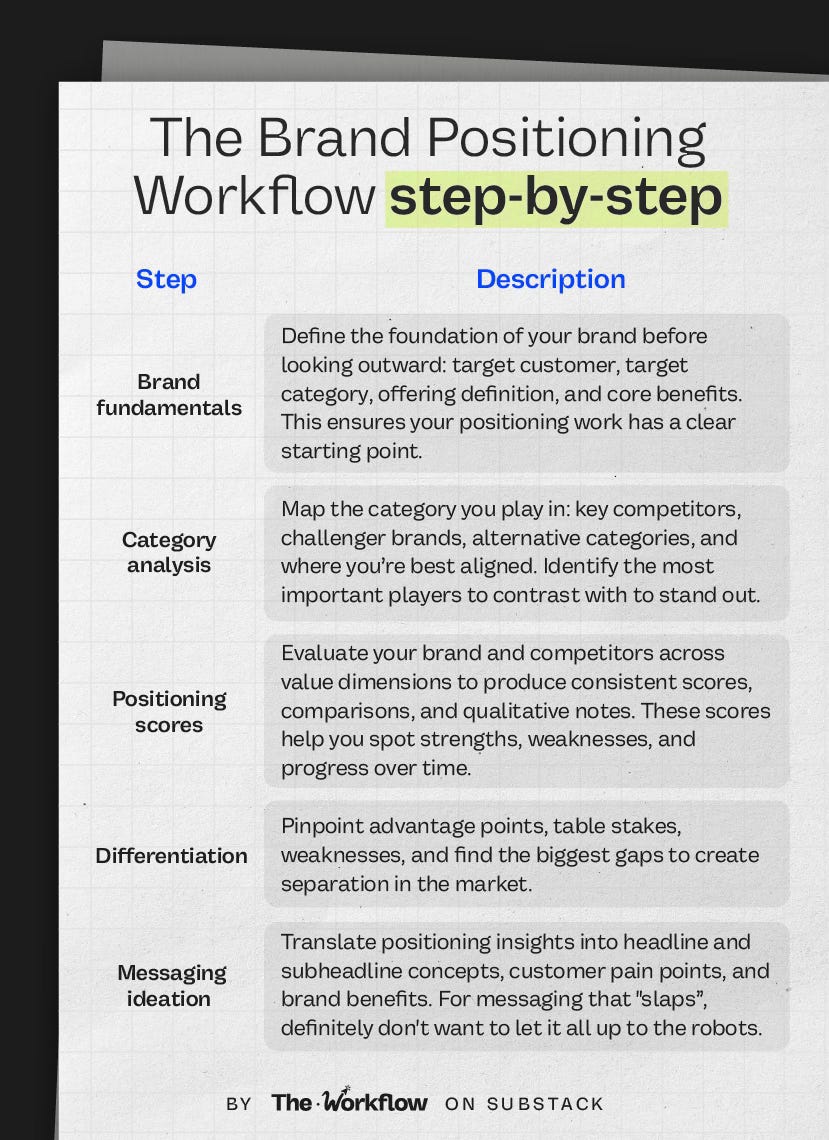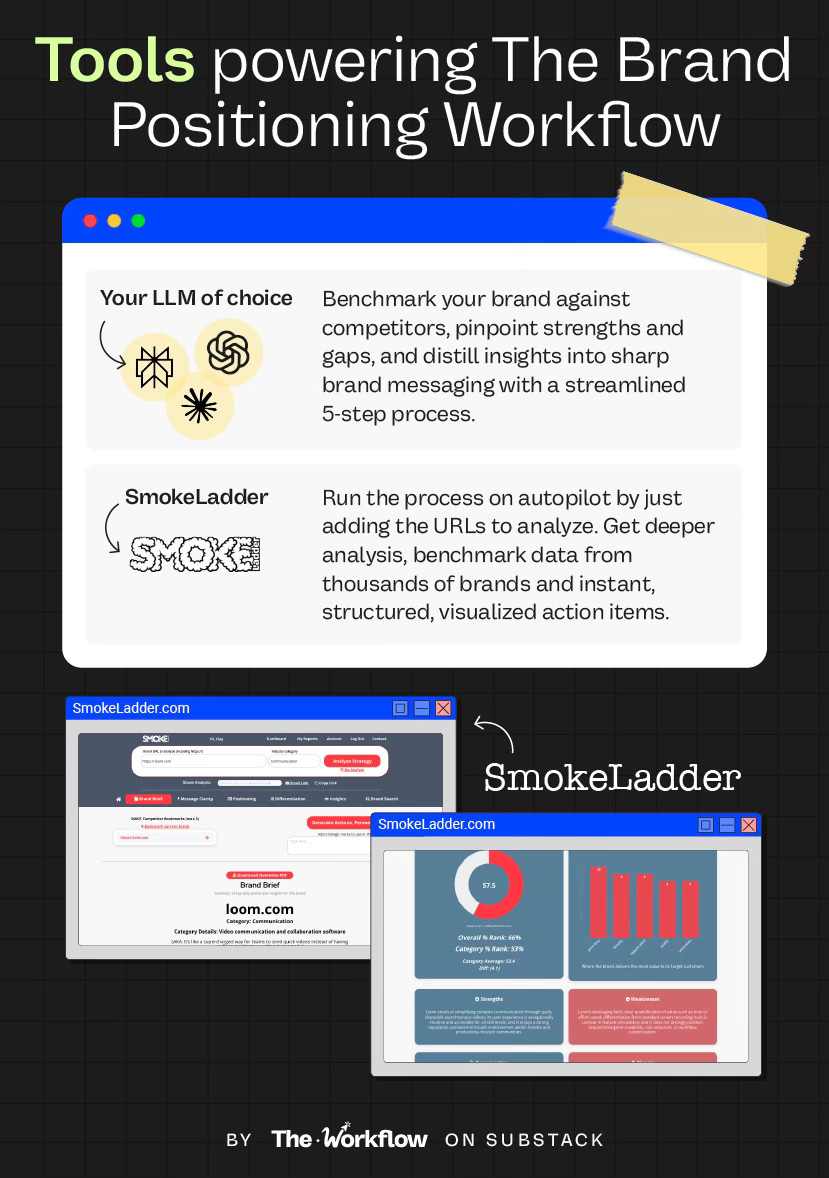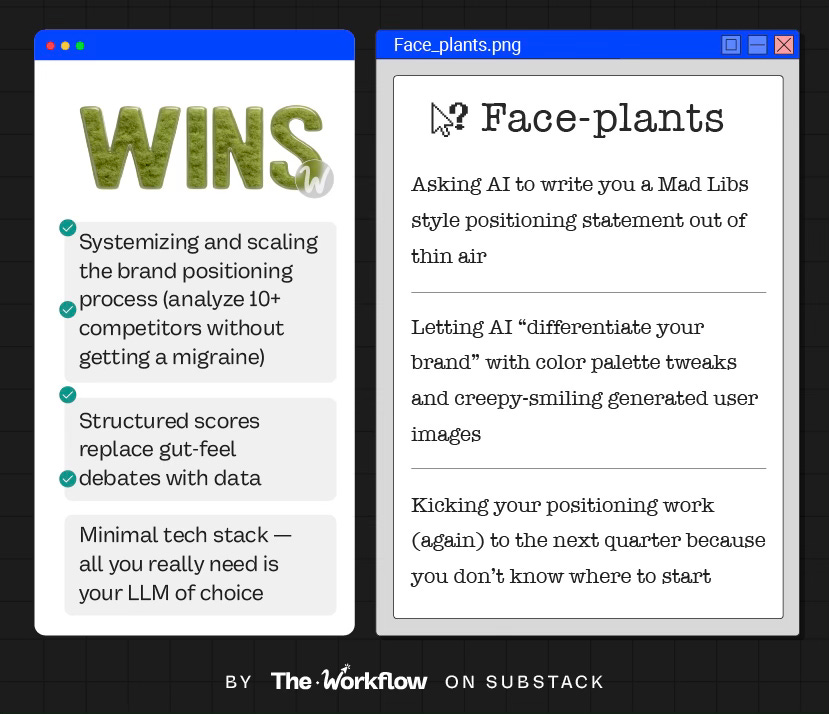The Brand Positioning Workflow for the AI era
Make your brand stand out with this highly strategic, simple workflow that turns positioning gut feel into scores and leaves your competitors wondering when you got so good.
We welcome you to the third issue of The Workflow, your new bi-weekly source of AI and automation playbooks for people who use tech to get real work done, not just post “comment playbook to get the playbook” on LinkedIn.
Whether you work in marketing, sales, or run your own thing, each issue delivers a real-world workflow from a business pro that you can replicate as you read.
Last time, HeyReach’s CMO showed us the behind-the-scenes of an AI lead scoring Workflow that doubled their free-to-paid conversions. This week, we’re jumping from something extremely measurable like lead scoring to something typically impossible to define: brand positioning. Spoiler alert: this week's guest built a workflow to make it more tangible (without breaking the magic).
✅ What you’ll learn
How to build a complete brand positioning workflow with AI
How to measure and quantify “brand” as much as possible
How to run competitive brand analysis, fast
How to create a reliable scoring system to analyze your brand
How to craft resonant messaging around your key differentiators
🧨 What triggered The Workflow
Our guest, Clay Ostrom, founder of brand strategy agency Map & Fire, worked in the past with giants like Google, Sony, and Mattel and has spent the last 10 years helping everyone from scrappy startups to SMBs stand out in crowded markets.
Thanks to the AI boom, that job just got a whole lot harder.
“I started noticing how businesses, especially in SaaS, aren’t just up against two or three rivals anymore. They’re up against 10–15, each chipping away at market share.”, Clay told us.
The good old “gut feel” approach to positioning can’t keep up. Agencies like his feel it even more: every new client requires starting from zero on competitive analysis and messaging, often at high volume and under brutal timelines.
“It’s the classic ‘Here are 20 competitors and 50 internal docs to review for our kickoff tomorrow’ kind of thing. We need better tools. As competition levels go up, we have to fight fire with fire.”
His answer? A workflow that turns fuzzy positioning into something measurable and actionable, helping you quickly analyze dozens of brands, understand their superpowers, and position against them effectively.
Clay even built his own tool, SmokeLadder, to automate and scale the process. But here’s the best part: he’s sharing a slimmed down version of that workflow that you can run with any of your favorite LLMs (probably ChatGPT, Claude, or Perplexity, we’re guessing).
Want to replicate this workflow or tweak it for your own use case? Keep reading.
🛠️ How to build The Workflow
This Workflow is your playbook for defending (and winning) your brand budget.
It takes one of the most abstract, “fluffy” aspects of marketing — positioning — and makes it concrete, structured, and even measurable. Follow these steps and you’ll have hard evidence to back up your brand decisions, instead of hand-waving through strategy decks. If more SaaS companies did this, we’d all spend less time squinting at homepages wondering, “But what does this tool actually do?”
Clay has gifted us some simplified prompts for each step listed below (thank you, Sir!), so you can grab a coffee, fire up your favorite LLM, and start running your first AI-powered positioning sprint today. If you want to go further, SmokeLadder (his platform) pulls these steps into one streamlined workspace, provides deeper consistent scoring, and layers in benchmark data to help you see exactly where your brand stands.
1. Nail your brand fundamentals
Before you can position against competitors, you need a crystal-clear definition of your own brand’s foundation. This step is all about answering: Who do we serve? Where do we play? What needs are we solving?
To define your brand, you need absolute clarity on these points:
Target customer – the exact audience you’re trying to reach
Target category – the market space you want to own
Offering definition – what you actually provide
Core benefits – the value your product or service delivers
💬 Clay doesn't beat around the bush: “If you can’t articulate this internally in plain language, it’s impossible to differentiate externally.”
For demonstration purposes, we'll use ChatGPT to analyze and build Tella's positioning, a screen recording and editing tool:
2. Analyze the brand category
Now it's time to understand the ecosystem you’re stepping into. This step is all about answering: “Who else plays in our space? How are they framing themselves? Where do we have room to stand out?”
You'll need to map out:
Category alignment – the primary category your audience would place you in
Alternative categories – other spaces you could credibly compete in
Key competitors – the main players to benchmark against
Challenger brands – emerging or niche players making interesting moves
🗺 By now, you should have a clear map of the players that matter most; the ones you need to contrast with if you want to stand out.
And that’s just the enrichment layer. With a detailed profile built out (including ICP match, firmographics, behavior, and job titles), each lead is now ready for scoring, assignment to a responsible team member, and for a suitable next step.
3. Score your brand (and your competitors)
This is where positioning gets tangible. Instead of playing the “We’re the best!” card, you will turn differentiation into numbers.
Clay’s philosophy: “If you can quantify it, even if it’s subjective, it’s a lot easier to find points of improvement.”
Score your brand and your competitors across these dimensions:
Value delivered – how much your offer satisfies customer needs
Differentiation – how clearly you stand apart in the market
Category fit – how well you align with the space you’re competing in
🧮 The scores aren’t set in stone; they’re a reliable compass for spotting strengths, weaknesses, and areas to refine.
4. Lean into your brand differentiators
With scores and comparisons in hand, it’s time to figure out where you can stand out the most. This step breaks your brand into:
Advantage points – the unique value you deliver that others can’t match
Table stakes points – things you must have just to stay in the game
Weakness points – areas where competitors currently outshine you
Where to double down – the strengths that can set you apart even more
🤑 The goal here is simple: maximize separation from the competition by leaning into your most unique points of value. As Clay puts it, “The magic isn’t just spotting where you’re strong; it’s deciding where that strength will actually win you customers.”
5. Craft resonating brand messaging
Wild how many people think this is the first (and often the only) step of brand positioning. In reality, it’s the last mile. By the time you get here, you’ve already mapped your category, identified competitors, scored your positioning, and pinpointed your unique advantages. Now, you’re turning all that evidence into words.
In this stage, you’ll craft:
Headline concepts – The core statement that captures your brand’s promise.
Subheadline concepts – A concise expansion that explains how you deliver that promise.
Customer pain points – The problems your audience feels most acutely.
Brand benefits – The tangible value you deliver to solve those pains.
Clay notes, “You’re no longer starting from a blank page; you’re now starting from hard evidence.” That’s why your messaging will land stronger, read sharper, and connect faster.
⚠️ Note: While AI tools can help you brainstorm messaging ideas and angles, we still recommend having a human copywriter shape the final product because nuance, tone, and emotional resonance are what make the words stick.
🤖 Tools powering the Workflow
Sara made fun of her pretty basic tech stack for executing the Marketing Report Workflow, but this tech stack is next-level minimalist. All you really need is your LLM of choice (ChatGPT, Claude, Perplexity… pick your poison).
Alternatively, if you want an all-in-one option that lets you plug in URLs and get structured scores, visualized outputs, and strategic insights without juggling 15 spreadsheet tabs, that’s where SmokeLadder comes in. That's it.
We love workflows like this because they show how tech can accelerate an evergreen strategic project, making it faster, scalable, and easier, without pretending the tech is the strategy. Positioning still depends on your thinking and product, not on how many tools you stack.
⚠️The size of your tool list says nothing about how good of a marketer you are (although many people on LinkedIn clearly disagree).
🎢 Highs, lows and Workflow warnings
The magic of this workflow is how straightforward and repeatable it is. Once you’ve run it a few times, it becomes second nature. The best part is how it turns a notoriously fuzzy process into a clear, objective sequence you can run for any brand (or multiple brands at once, if you're an agency) without drowning in open tabs or spreadsheet hell.
Clay points out that having structured scores for positioning “pulls the soul of your brand out of your head and gets it on paper” — a huge advantage when conversations drift into subjective debates. Instead of arguing over gut feel, you’ve got data.
That said, here are the most common brand positioning mistakes to avoid:
Garbage in, garbage out. If your inputs (competitor sites, messaging, product info) aren’t accurate or up to date, your scores will reflect that. Clay stresses the importance of sanity-checking sources before running the analysis.
Don’t skip the foundation work. Many people want to jump straight to crafting messaging, but without clear answers to “Who do we serve?” and “What category do we play in?”, you’re polishing fluff.
AI ≠ copywriter. Even with sharp insights and competitor breakdowns, the final messaging still needs a human brain (and tone). Think of this workflow as your research muscle, not your brand voice.
✨ The Goldflow
AI is fast. Too fast. But the beauty of this workflow is that it forces you to slow down where it matters. Positioning isn’t a “set it and forget it” document you dig up once a year; it’s a living strategy that needs regular stress-testing. AI just makes it easier to run that test so it doesn’t feel like a dreaded maintenance chore.
Clay’s biggest takeaway is to stack prompts and break the process into pieces. Don’t feed an LLM the whole brand universe and expect gold to spill out. Run the competitive scan. Validate your sources. Score your position. Then step back and think. That’s the part AI can’t do for you (and the part that makes all the difference).
It’s tempting to chase the perfect headline straight out of the gate, but the real win here is having a repeatable, data-backed lens on your market. When you know exactly where you stand, every creative choice stops being a gamble and starts being a strategy.
Maybe you’ll even join the top 3% of B2B companies where visitors instantly “get” what you do.
See you at the next Workflow,
Sara & Diandra
💡Know someone working on their positioning?
🌯 It’s a major wrap
This was the third edition of The Workflow, a bi-weekly newsletter by Sara Lattanzio & Diandra Escobar, featuring one real workflow that moved the needle for someone even smarter than the system they built.
We could get used to this: collecting battle-tested workflows from ridiculously sharp people and passing them on like contraband. Next issue’s already cooking.
💌 Loved this issue and want to show us a little kindness?



